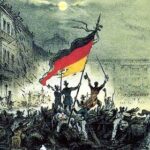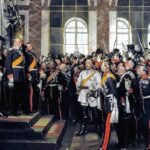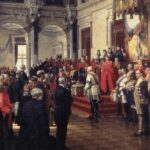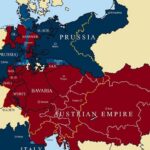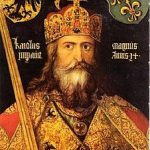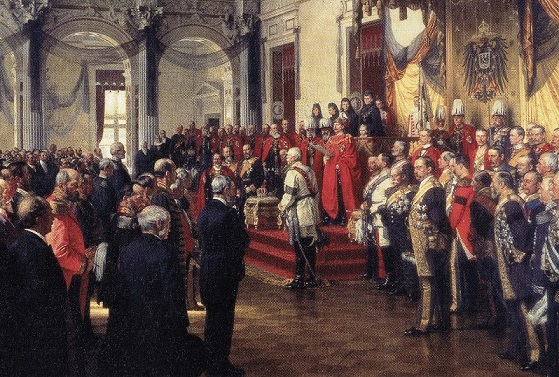
In 1800, there was no Germany – at least not in the form we know today. Instead, the region was a patchwork of over 300 kingdoms, duchies, and free cities, all loosely connected by language but divided by law, custom, and ruler. Yet by 1871, these pieces had fused into one of the most powerful empires in Europe.
The story of 19th Century and German Unification is one of transformation – marked by revolution, war, diplomacy, and industrial might. The century saw dreamers and strategists, students and soldiers, liberals and conservatives all shape what would become modern Germany.
This category explores that story in full. From the barricades of 1848 to the halls of Versailles, you’ll discover how a modern nation was built – and why it matters today. Whether you’re a student, traveler, or history enthusiast, welcome to the century that changed everything.
Category Overview
The road to German unification was neither short nor simple. After the collapse of the Holy Roman Empire in 1806 – prompted by Napoleon’s reordering of Europe – the German-speaking world was left fragmented. Napoleon replaced the old empire with the Confederation of the Rhine, which grouped several of the former territories under French protection. While it simplified the landscape, it didn’t solve the bigger question: what should Germany be?
After Napoleon’s fall, the Congress of Vienna in 1815 created the German Confederation, a coalition of 39 sovereign German states led by Austria. It was intended to maintain peace and balance, but instead it entrenched division. Austria and Prussia, the two largest powers, vied for influence, while growing calls for liberal reform and national unity echoed throughout the smaller states.
These tensions exploded in the 1848 Revolutions, where nationalists and liberals tried – unsuccessfully – to create a unified, democratic Germany. Although the revolution failed, it left behind a powerful legacy.
In the decades that followed, Prussia stepped into the leadership role. Through a mix of diplomacy, war, and sheer political cunning, Otto von Bismarck orchestrated the formation of the German Empire in 1871, uniting most of the German-speaking world under Prussian dominance.
This century wasn’t just about borders – it was about building identity, industry, and modern institutions. The story of unification is as much about ideas and culture as it is about armies and treaties.
The 1848 Revolutions in the German States
The 1848 Revolutions were a wave of uprisings across Europe, and the German Confederation wasn’t spared. Protesters from Berlin to Vienna demanded liberal constitutions, press freedom, and, above all, national unity. A national assembly even met in Frankfurt’s Paulskirche to draft a constitution for a united Germany.
But dreams ran up against entrenched power. Monarchs backtracked on concessions. The Frankfurt Assembly offered the German crown to Prussia’s king – he refused it. By 1849, the revolution had collapsed. Yet its legacy endured.
It planted the seeds of future unity and introduced political ideas that would later return in full force.
Otto von Bismarck and Realpolitik
Few figures shaped modern Germany more than Otto von Bismarck. Appointed Prime Minister of Prussia in 1862, he believed in Realpolitik – politics based on power and pragmatism rather than ideals. Bismarck wasn’t interested in parliaments or manifestos. He unified Germany through war, diplomacy, and manipulation.
First, he provoked conflict with Denmark to build nationalist sentiment. Then he defeated Austria to remove its influence from German affairs. Finally, by orchestrating the Franco-Prussian War, he rallied the southern German states to unite with the north. By 1871, Bismarck had crafted the German Empire – with Prussia firmly at the helm.
His strategies laid the foundation for modern German statecraft and turned unification from a dream into political reality.
The Austro-Prussian War (1866)
The Austro-Prussian War was brief – just seven weeks long – but it changed everything. For decades, Austria had dominated the German Confederation. Prussia, under Bismarck, was determined to change that. Tensions flared over the administration of Schleswig and Holstein, two duchies won from Denmark.
Bismarck used the dispute as a pretext for war. In 1866, Prussian forces decisively defeated Austria at the Battle of Königgrätz. The result? Austria was excluded from German affairs, and the North German Confederation was formed under Prussian leadership.
This was a turning point. It established Prussia – not Austria – as the leader of the unification effort. The door was now open for a fully unified Germany – one that would not include Austria.
The Franco-Prussian War (1870 – 71)
The final step toward unification came through war with France. Bismarck cleverly edited the Ems Dispatch, a diplomatic telegram, to insult the French and provoke a reaction. The strategy worked. France declared war, and the southern German states – previously hesitant – rallied behind Prussia.
The German coalition won swiftly. At Sedan, Napoleon III was captured, and Paris soon fell. This overwhelming victory stirred national pride across German territories. It wasn’t just a win on the battlefield – it was the emotional catalyst for unity.
In January 1871, with France humiliated, the German Empire was proclaimed in the Hall of Mirrors at Versailles. Bismarck had achieved what decades of revolutionaries couldn’t: unification through strength.
The Proclamation of the German Empire (1871)
After decades of division and years of conflict, the dream of a unified Germany became a reality on January 18, 1871. In a highly symbolic moment, German princes gathered in the Hall of Mirrors at the Palace of Versailles, just outside conquered Paris, to proclaim the formation of the German Empire.
Wilhelm I, King of Prussia, was declared Kaiser (Emperor) of this new empire. It was a moment of triumph not just for the military, but for nationalist movements that had long dreamed of unification.
But it also sent a message: Germany had arrived, and it had done so on its own terms – through Prussian dominance, not liberal revolution.
Industrialization and Urbanization in Germany
German unification didn’t just happen on the battlefield – it happened in the factory. The 19th century saw Germany shift from a primarily agrarian society to an industrial giant. Fueled by coal from the Ruhr Valley and iron from Silesia, Prussia led the way in developing steelworks, chemical industries, and railways.
Cities like Berlin, Leipzig, and Dresden expanded rapidly. Infrastructure like the Zollverein (customs union) facilitated trade and economic integration well before political unity was achieved.
Industrialization brought profound social change. A new middle class emerged, while millions of rural laborers became urban workers. This transformation laid the groundwork for labor movements and redefined how Germans lived, worked, and saw their place in the world.
- [Industrialization and Urbanization in Germany]
Socialism and the SPD in the 19th Century
With industrial growth came social inequality. Factory workers faced long hours, low wages, and poor living conditions. These realities fueled the rise of socialism in Germany. In 1875, two worker-oriented political movements merged to form the Social Democratic Party of Germany (SPD).
Though Bismarck viewed socialism as a threat and tried to suppress it through the Anti-Socialist Laws, he also introduced landmark welfare programs – health insurance, pensions, and accident insurance – to win over the working class. Ironically, his crackdown helped legitimize the movement he feared.
The SPD grew into the largest party in the Reichstag by the early 20th century. Its influence reshaped not only labor rights, but Germany’s political culture for generations.
- [Socialism and the SPD in the 19th Century]
German Colonial Ambitions
After unification, the German Empire began looking outward. Though late to the game, Germany joined the European race for overseas colonies in the late 19th century. Under Kaiser Wilhelm I and later Wilhelm II, Germany acquired territories in Africa (such as German East Africa, Cameroon, and Southwest Africa) and the Pacific (including parts of New Guinea and Samoa).
Colonialism became both a symbol of national prestige and a source of economic resources. It was also a tool of domestic unity – diverting attention from internal tensions by rallying around imperial ambitions.
Germany’s colonial period was relatively short-lived but deeply impactful. It shaped foreign policy, intensified rivalries with Britain and France, and left legacies still debated today.
- [German Colonial Ambitions]
Cultural Significance and Practical Applications
Unification didn’t just reshape maps – it reshaped minds, architecture, and identities. The 19th century built not just a nation, but a shared sense of being German. Public art, education, language, and even holidays were refashioned to reflect national unity and imperial pride.
Monuments and memorials dedicated to Bismarck and battlefield victories appeared in towns across the empire. Cities like Berlin, Munich, and Leipzig embraced grandeur in architecture – symbolizing a confident new nation.
The government standardized the German language in schools and state documents, promoting linguistic unity across regions with wildly different dialects. Public schooling and national holidays reinforced a unified historical narrative.
Today, you can still experience this era firsthand:
- Walk through the Reichstag, the seat of modern democracy that began its life as the Imperial Parliament.
- Explore Paulskirche in Frankfurt, the birthplace of German parliamentary ideals.
- Visit Bismarck towers scattered across Germany – symbols of national memory and pride.
The echoes of 19th-century unification continue to influence modern debates about German identity, federalism, and Germany’s role in Europe.
The 19th century was a turning point not just for Germany, but for Europe. It witnessed the unification of a fragmented region into a cohesive empire, built on the back of revolution, Realpolitik, and rising industrial power. What had once been a dream of poets and idealists became a project of generals and statesmen.
The legacy of this century still defines Germany today – its federal structure, cultural institutions, and cautious foreign policy all stem from lessons learned during unification.
This category invites you to explore that transformation. Whether you’re interested in revolution, empire-building, or the lives of ordinary citizens during extraordinary times, these articles offer a window into a formative era.
So take the next step. Explore our in-depth features on Bismarck, the revolutions of 1848, the rise of socialism, and more – and see how 19th Century and German Unification continues to shape Germany’s national identity.
